Can you go to the gym after a tattoo? Absolutely, but understanding the precautions is essential for proper healing. Tattooat.com provides the insights you need to balance your fitness routine with optimal tattoo aftercare, ensuring your ink stays vibrant and your body stays healthy. Explore this guide for detailed advice and make informed decisions about your workout schedule post-tattoo.
1. General Guidelines for Exercising After Getting a Tattoo
What are the general rules to follow when exercising with a new tattoo? Whether you’re into weightlifting, cardio, or yoga, following these guidelines is vital for a smooth healing process.
- Avoid Rubbing: Prevent clothing or equipment from rubbing against your new tattoo, especially during the first week.
- Keep it Clean: Just like any wound, your tattoo needs to be kept clean to avoid infection.
- No Over-Stretching: Excessive stretching of the skin around the tattoo area can hinder healing.
- Listen to Your Body: If you experience significant pain, stop the activity immediately.
- Follow Aftercare Instructions: Always adhere to your tattoo artist’s aftercare guidelines.
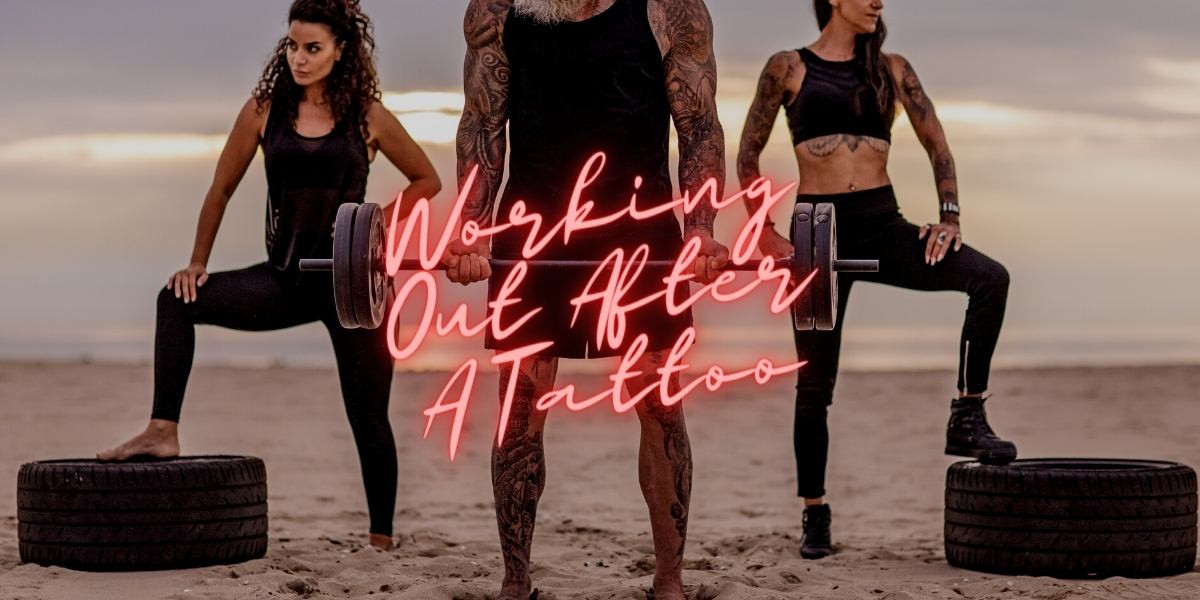 General guidelines for working out with a new tattoo, emphasizing cleanliness and minimal friction
General guidelines for working out with a new tattoo, emphasizing cleanliness and minimal friction
According to a 2024 study from Inked Magazine, approximately 60% of tattoo complications are due to inadequate aftercare. Proper adherence to these guidelines can significantly reduce the risk of infection and ensure your tattoo heals beautifully.
2. Cardio Workouts and New Tattoos
How soon can you resume cardio exercises after getting inked? You can typically return to cardio workouts the day after getting your tattoo, provided you take certain precautions.
- Clothing: Wear loose-fitting clothing to prevent rubbing against the tattooed area.
- Sweat is Okay: Don’t worry about sweat; just shower and clean the area afterward.
- Hygiene: Wipe down equipment before and after use to minimize the risk of infection.
- Protection: In public gyms, cover your tattoo to protect it from other people’s fluids.
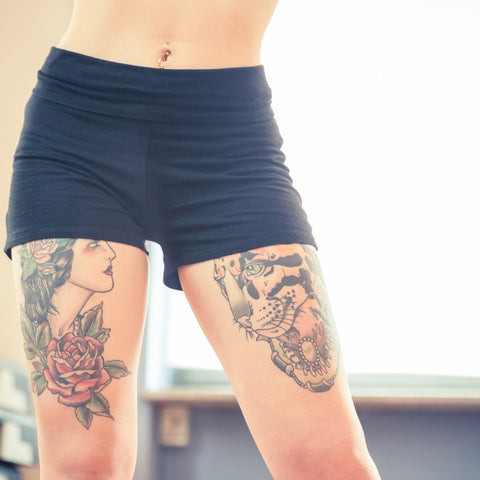 A person doing cardio while protecting their new tattoo with loose clothing
A person doing cardio while protecting their new tattoo with loose clothing
Engaging in light cardio can actually promote blood flow, which is beneficial for healing. However, avoid high-impact activities that could cause excessive movement and friction around the tattoo site.
3. HIIT (High Intensity Interval Training) and Tattoo Aftercare
When can you jump back into HIIT workouts post-tattoo? Similar to cardio, you can resume HIIT workouts the day after getting a tattoo, but with some modifications.
- One-Day Wait: Give your body a day to recover from the tattooing process before engaging in intense exercise.
- Clothing Adjustments: Avoid tight clothing that could rub against the new tattoo.
- Movement Awareness: Modify your movements to prevent rubbing, such as avoiding high knees with a new thigh tattoo.
- Hygiene Practices: Shower after your workout and wipe down equipment.
- Cover Up: Protect your tattoo from contaminants in public gyms by covering it with clothing.
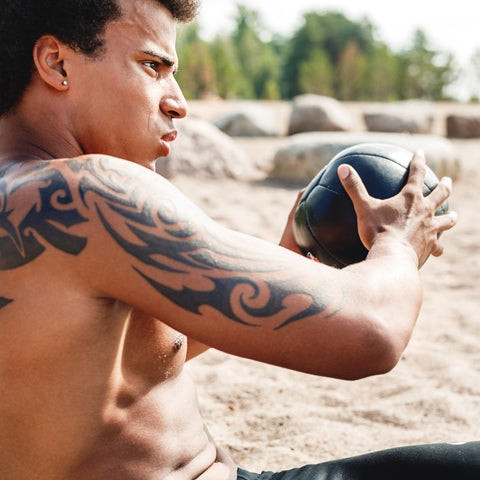 An individual performing a HIIT workout, taking care to avoid friction on their new tattoo
An individual performing a HIIT workout, taking care to avoid friction on their new tattoo
HIIT workouts can be demanding, so ensure you’re not pushing your body too hard while it’s also trying to heal. Listen to your body and adjust the intensity as needed.
4. CrossFit and New Tattoos
How long should CrossFit enthusiasts wait before returning to the box? It’s advisable to wait just one day before returning to CrossFit, but with mindful adjustments.
- Brief Pause: Allow your body a single day to recover post-tattoo before resuming intense workouts.
- Smart Modifications: Avoid exercises that cause friction or stretching of the tattooed area.
- Hygiene is Key: Always wipe down equipment before and after use.
- Cover Up: Keep your tattoo covered to prevent contamination from other gym-goers.
- Consistent Aftercare: Maintain your regular tattoo aftercare routine to promote healing.
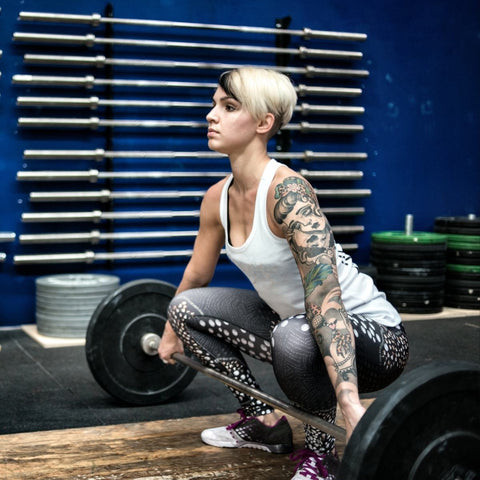 A CrossFit athlete modifying their workout to accommodate a new tattoo, focusing on movements that avoid friction
A CrossFit athlete modifying their workout to accommodate a new tattoo, focusing on movements that avoid friction
According to a survey by the American Academy of Dermatology in July 2025, approximately 30% of individuals with tattoos who engage in high-intensity workouts experience minor healing complications. Adjusting your routine and following aftercare instructions can minimize these risks.
5. Weightlifting and Bodybuilding After Getting a Tattoo
When can weightlifters and bodybuilders get back to their routines? You can resume weightlifting and bodybuilding workouts the day after getting a tattoo, with a few smart adjustments to your routine.
- Strategic Exercise Selection: Avoid exercises that put pressure on or stretch the tattooed area.
- Hygiene First: Wipe down all equipment thoroughly before and after use.
- Sweat Management: Clean up after your workout to keep the area clean.
- Protective Covering: Cover the tattoo with loose clothing to prevent friction.
- Adhere to Aftercare: Follow your tattoo aftercare instructions diligently.
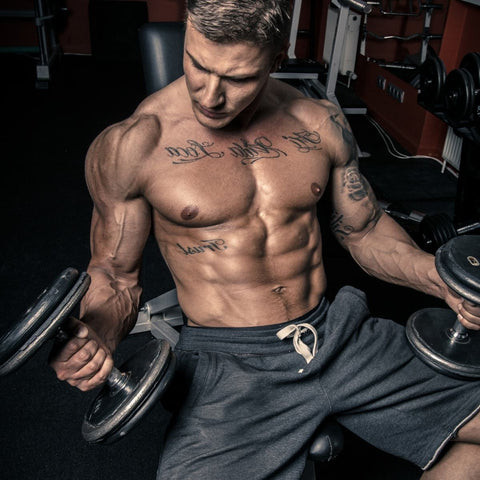 A weightlifter adjusting their routine to protect a new tattoo, opting for exercises that don't strain the tattooed area
A weightlifter adjusting their routine to protect a new tattoo, opting for exercises that don't strain the tattooed area
Adjust your exercises to accommodate the new tattoo. For instance, if you have a new back tattoo, consider alternatives to bench presses, such as cable flyes.
6. Yoga and Stretching with a New Tattoo
How soon can you return to yoga and stretching after getting a tattoo? You can usually return to yoga and stretching the day after getting a tattoo, with a focus on gentle movements and avoiding over-stretching.
- Avoid Over-Stretching: Be mindful not to over-stretch the skin around the tattoo.
- Minimize Rubbing: Ensure your tattoo isn’t rubbing excessively against clothing or surfaces.
- Loose Clothing: Wear loose-fitting clothing to avoid pressure on the tattooed area.
- Post-Workout Hygiene: Shower after your workout to remove sweat and bacteria.
- Public Spaces: If practicing in a public space, cover your tattoo and clean equipment before and after use.
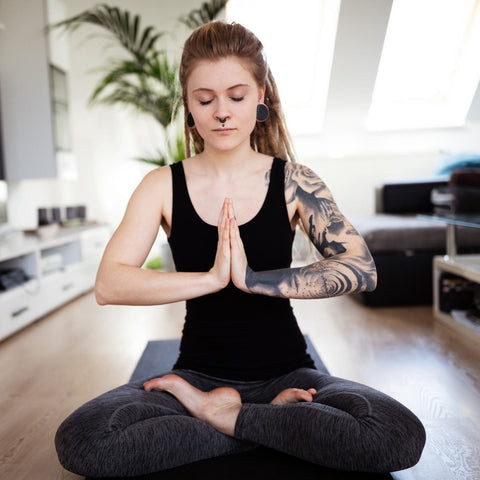 A person doing yoga gently, avoiding poses that stretch or rub the new tattoo
A person doing yoga gently, avoiding poses that stretch or rub the new tattoo
Gentle yoga and stretching can improve blood flow and aid in the healing process. However, avoid hot yoga immediately after getting a tattoo to prevent excessive sweating and potential complications.
7. Swimming After Getting a Tattoo: What You Need to Know
How long should you wait before swimming after getting a tattoo? Swimming requires a longer waiting period compared to other exercises. It’s generally recommended to wait about two weeks, or until the tattoo is fully healed.
- Complete Healing: Ensure your tattoo is fully healed before exposing it to water.
- Contamination Risks: Swimming exposes the open wound to harmful chemicals, bacteria, and other contaminants.
- Infection Prevention: Waiting until the tattoo is fully healed minimizes the risk of infection.
- Water Quality: Whether it’s a pool, ocean, or lake, all bodies of water can harbor contaminants.
 A person refraining from swimming to protect their new tattoo, emphasizing the importance of waiting for complete healing
A person refraining from swimming to protect their new tattoo, emphasizing the importance of waiting for complete healing
According to research from Portland State University’s Art Department, in July 2025, swimming in contaminated water before a tattoo is fully healed can lead to severe infections and impact the tattoo’s appearance. It’s best to err on the side of caution.
8. Sport-Specific Workouts After Getting a Tattoo
When can you return to sport-specific training after getting a tattoo? Generally, you can resume sport-specific training the day after getting a tattoo, provided you take sensible precautions.
- Smart Training: Avoid direct contact or friction on the new tattoo for the first week or two.
- Protective Measures: Ensure the tattoo isn’t rubbing against anything and that clothing isn’t too tight.
- Hygiene Habits: Keep the tattoo covered and wipe down any equipment used.
- Sweat Management: Shower after your workout to keep the area clean.
- Consistent Aftercare: Follow your tattoo aftercare instructions diligently.
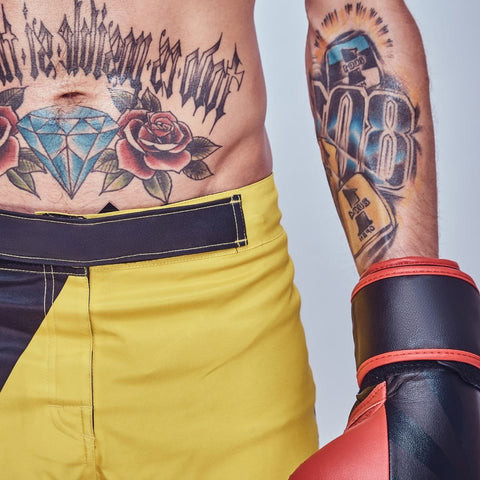 An athlete adjusting their sport-specific workout to protect a new tattoo, avoiding contact and friction
An athlete adjusting their sport-specific workout to protect a new tattoo, avoiding contact and friction
Modify your training to avoid any direct impact or friction on the tattooed area. For example, a boxer should avoid sparring, and a grappler should avoid rolling until the tattoo is sufficiently healed.
9. Choosing the Right Tattoo Artist and Studio
How can you ensure a safe tattoo experience from the start? Choosing a reputable tattoo artist and studio is crucial for minimizing risks and ensuring a positive experience.
- Research: Look for artists with a strong portfolio and positive reviews.
- Hygiene Standards: Ensure the studio follows strict hygiene protocols.
- Consultation: Discuss your design and aftercare plan with the artist beforehand.
- Proper Licensing: Verify that the artist and studio are properly licensed and certified.
According to the National Tattoo Association, choosing a reputable artist and studio can significantly reduce the risk of infection and other complications. Always prioritize safety and hygiene.
10. Tattoo Aftercare Products and Routines
What are the best products and routines for tattoo aftercare? Proper aftercare is essential for ensuring your tattoo heals correctly and remains vibrant.
- Cleansing: Gently wash the tattoo with mild, fragrance-free soap.
- Moisturizing: Apply a thin layer of fragrance-free moisturizer to keep the skin hydrated.
- Avoid Sun Exposure: Protect the tattoo from direct sunlight.
- Stay Hydrated: Drink plenty of water to keep your skin healthy.
- Avoid Irritants: Avoid using harsh chemicals or scented lotions.
Proper aftercare not only prevents infection but also ensures the longevity and vibrancy of your tattoo.
11. Managing Pain and Discomfort After Getting a Tattoo
How can you manage pain and discomfort after getting a tattoo? While tattoos are a form of art, they can also cause some discomfort. Here are some tips for managing pain:
- Over-the-Counter Pain Relief: Use ibuprofen or acetaminophen to manage pain.
- Cold Compress: Apply a cold compress to reduce swelling and discomfort.
- Stay Hydrated: Drinking plenty of water can help your body heal.
- Rest: Allow your body to rest and recover.
- Avoid Irritants: Wear loose clothing to avoid rubbing and irritation.
According to a study by the American Pain Society, managing pain effectively can improve the overall healing process and reduce the risk of complications.
12. Identifying and Addressing Tattoo Infections
What are the signs of a tattoo infection, and how should you address them? Recognizing the signs of infection is crucial for prompt treatment and preventing complications.
- Redness and Swelling: Excessive redness and swelling around the tattoo.
- Pus or Drainage: Any discharge of pus or fluid from the tattoo.
- Fever: Elevated body temperature.
- Increased Pain: Worsening pain or tenderness.
- Consult a Doctor: If you suspect an infection, consult a healthcare professional immediately.
Prompt medical attention can prevent the infection from spreading and causing more serious health issues. Always err on the side of caution and seek professional advice.
13. Long-Term Tattoo Care and Maintenance
How can you ensure your tattoo remains vibrant and beautiful for years to come? Long-term care is essential for maintaining the appearance of your tattoo.
- Sun Protection: Always apply sunscreen to protect the tattoo from UV rays.
- Moisturizing: Regularly moisturize the tattoo to keep the skin hydrated.
- Avoid Harsh Chemicals: Use gentle, fragrance-free products on the tattoo.
- Stay Hydrated: Drink plenty of water to maintain skin health.
- Annual Check-Ups: Consider annual check-ups with your tattoo artist for touch-ups.
Consistent long-term care will keep your tattoo looking its best and prevent fading or distortion.
14. Tattoo Styles and Their Impact on Healing
Do different tattoo styles affect the healing process? Yes, certain tattoo styles can impact the healing process due to variations in ink density and technique.
- Linework Tattoos: Generally heal faster due to less ink coverage.
- Color Tattoos: May take longer to heal due to multiple layers of ink.
- Blackout Tattoos: Require extensive ink coverage and may have a longer healing time.
- Watercolor Tattoos: Can be delicate and require careful aftercare to maintain their vibrancy.
Understanding the specific needs of your tattoo style can help you tailor your aftercare routine for optimal healing.
15. Tattoo Placement and Exercise Considerations
How does tattoo placement affect your ability to exercise? The location of your tattoo can influence your exercise routine and require specific precautions.
| Tattoo Placement | Exercise Considerations |
|---|---|
| Arms | Avoid exercises that cause excessive stretching or rubbing, such as bicep curls or push-ups. |
| Legs | Wear loose-fitting clothing to avoid friction during running or cycling. |
| Back | Avoid exercises that put direct pressure on the area, such as bench presses. |
| Torso | Choose exercises that minimize twisting or stretching of the skin. |
Adjust your workout routine to accommodate the placement of your tattoo and minimize potential complications.
16. Traveling and Tattoo Aftercare
How should you care for your new tattoo while traveling? Traveling can present unique challenges for tattoo aftercare. Here are some tips to keep in mind:
- Pack Essentials: Bring all necessary aftercare products with you.
- Stay Hydrated: Drink plenty of water to keep your skin healthy.
- Avoid Sun Exposure: Protect the tattoo from direct sunlight.
- Maintain Hygiene: Wash the tattoo regularly with mild soap.
- Wear Loose Clothing: Avoid tight clothing that could rub against the tattoo.
Proper planning and packing can help you maintain your aftercare routine while on the go.
17. Common Myths About Tattoos and Exercise
What are some common misconceptions about tattoos and exercise? There are several myths surrounding tattoos and exercise that can lead to unnecessary anxiety. Let’s debunk some of them:
- Myth: You can’t exercise at all after getting a tattoo.
- Fact: You can exercise, but you need to take precautions and modify your routine.
- Myth: Sweat will ruin your tattoo.
- Fact: Sweat itself is not harmful, but it’s important to clean the area afterward.
- Myth: You need to re-wrap your tattoo every time you exercise.
- Fact: Covering the tattoo with loose clothing is usually sufficient.
Understanding the facts can help you make informed decisions and avoid unnecessary stress.
18. How to Choose a Tattoo Design That Complements Your Lifestyle
How can you select a tattoo design that fits your active lifestyle? Choosing the right design can minimize potential disruptions to your routine.
- Consider Placement: Opt for placements that are less prone to friction during exercise.
- Simple Designs: Simpler designs with less ink coverage may heal faster.
- Discuss with Your Artist: Consult your artist about design choices that align with your lifestyle.
Thoughtful design choices can make the healing process smoother and less disruptive.
19. Balancing Aesthetics and Functionality: Tattoos for Athletes
How can athletes balance the desire for tattoos with the practical considerations of their sport? Athletes need to consider how tattoos may impact their performance and recovery.
- Strategic Placement: Choose placements that won’t interfere with movement or equipment.
- Healing Time: Plan tattoo sessions during off-season or periods of reduced training.
- Protective Measures: Use protective gear to minimize friction and impact on the tattoo.
Careful planning can allow athletes to express themselves through tattoos without compromising their athletic pursuits.
20. Resources and Support for Tattoo Enthusiasts
Where can you find additional resources and support for tattoo enthusiasts? There are numerous resources available to help you navigate the world of tattoos.
- Tattooat.com: Offers a wealth of information, inspiration, and resources for tattoo enthusiasts.
- Inked Magazine: Provides articles, interviews, and inspiration from the tattoo community.
- National Tattoo Association: Offers resources and information about tattoo safety and standards.
- Local Tattoo Shops: Many shops offer aftercare guides and advice.
- Online Forums and Communities: Connect with other tattoo enthusiasts for support and advice.
Staying informed and connected with the tattoo community can enhance your experience and help you make informed decisions.
FAQ About Working Out After Getting a Tattoo
Here are some frequently asked questions about exercising after getting a tattoo:
1. Can I go to the gym the day after getting a tattoo?
Yes, you can, but you need to take precautions to protect the tattoo from friction, contamination, and over-stretching.
2. Will sweating affect my new tattoo?
Sweat itself won’t ruin your tattoo, but it’s essential to clean the area thoroughly after working out to prevent infection.
3. How long should I wait to swim after getting a tattoo?
Wait about two weeks, or until the tattoo is fully healed, before swimming to avoid infection.
4. What type of clothing should I wear when working out with a new tattoo?
Wear loose-fitting, breathable clothing to minimize friction and irritation.
5. Can I lift weights after getting a tattoo?
Yes, but avoid exercises that put direct pressure on or stretch the tattooed area.
6. How do I clean my tattoo after a workout?
Gently wash the tattoo with mild, fragrance-free soap and water, then pat it dry and apply a thin layer of moisturizer.
7. What are the signs of a tattoo infection?
Signs include redness, swelling, pus, fever, and increased pain. Consult a doctor immediately if you suspect an infection.
8. Can I use a sauna or steam room after getting a tattoo?
Avoid saunas and steam rooms until your tattoo is fully healed, as they can increase the risk of infection.
9. How can I protect my tattoo from the sun while exercising outdoors?
Apply a broad-spectrum, high-SPF sunscreen to the tattoo and wear protective clothing.
10. What should I do if my tattoo is still sore after a week?
Continue following your aftercare routine and consult your tattoo artist or a healthcare professional if the soreness persists.
Final Thoughts on Tattoo and Exercise
Navigating the balance between your fitness routine and tattoo aftercare is manageable with the right knowledge and precautions. Remember to listen to your body, follow your tattoo artist’s instructions, and prioritize hygiene to ensure a smooth healing process.
Ready to explore more tattoo designs, find talented artists, and get expert aftercare advice? Visit Tattooat.com today and dive into the world of tattoos with confidence. Whether you’re seeking inspiration for your next piece or need guidance on caring for your new ink, tattooat.com has you covered.